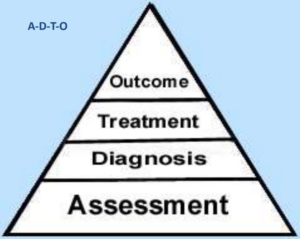In Part 2, I described how musculoskeletal diagnoses are currently made and treatments are prescribed. I showed that in many cases these decisions are based on a flawed model. I outlined how our current methods for managing musculoskeletal pain are not working as well as commonly assumed and showed that this is a very big, expensive problem, one that is only getting worse.
The new paradigm
The good news is that there is another approach. There is a new paradigm, a new interpretive grid, a new set of foundational assumptions regarding the diagnosis and treatment of musculoskeletal pain. This system doesn’t rely solely on pathoanatomical diagnoses. It is a way to assess and classify musculoskeletal pain without needing to determine the exact tissue causing the pain. This is good news, because as we saw in Part 2 our current methods don’t detect the tissue at fault very well anyway.
The new approach is called the McKenzie Method, also known as Mechanical Diagnosis and Therapy (MDT). The McKenzie Method is a framework for clinical decision making that uses a patient’s symptomatic and mechanical responses to mechanical loading (repeated movements or sustained postures) in order to classify them into a treatment specific subgroup. The value of the MDT system is that it isn’t dependent on unreliable tests or advanced imaging, rather it directly assesses the patient’s specific pain generator through movement and positioning.
In most cases, we don’t need to know which tissue is causing pain. We just need to know how the pain responds to the MDT exam. Based on the behavior of pain in response to this loading, a well trained MDT clinician can usually determine a classification and associated treatment.
The McKenzie Method follows the Assessment-Diagnosis-Treatment-Outcome (ADTO) model, where a validated assessment process leads to a precise diagnosis, which leads to a specific treatment, which ultimately leads to a predictable outcome. ADTO is a very linear, logical process where each step follows the previous step, with each level of the model refining the clinical decision making process and ultimately the outcome.

Said another way, a specific mechanical issue leads to a specific classification and a specific treatment. You wouldn’t get 10 different treatments for the same diagnosis as we saw with the pathoanatomical model. The MDT approach is really based on recognizing common symptomatic and mechanical patterns in response to movements and positions, and classifying patients based on these responses. Recognizing patterns allows the clinician to apply a systematic approach to resolving it, as the intervention is directly related to the diagnosis (the treatment specific subgroup). This is completely opposite from the classic approach of applying generalized treatments to diagnoses that are based solely on often unreliable tests that usually don’t give clear information regarding effective treatment.
Precision medicine
In his book, The Innovator’s Prescription: A Disruptive Solution for Health Care, best-selling author Clayton Christensen lays out a model for cutting costs and improving outcomes in health care. In it, he uses the term ‘Precision Medicine’, where personalized care is able to be delivered at a lower cost. Here, when predictably effective treatments are applied to precise diagnoses, it leads to improved outcomes. Sounds like the ADTO model. What most people in the broader medical community do not know, unfortunately, is that MDT already fits this definition. Even though it has been around for decades, based on this fact, the McKenzie Method has the power to be the future of conservative musculoskeletal medicine.
As stated earlier, when treatment is matched to the specific MDT classification, outcomes are very favorable. This has been demonstrated through great research. In addition, the ability for well trained McKenzie Method clinicians to come to the same conclusions regarding classification and treatment is very high. This is termed inter-tester reliability, and demonstrates the great standardization within the MDT system. If you visit a McKenzie Method clinician in Silverdale, Washington or Paris, France with the same clinical presentation, it is very likely that you will receive the same classification and the same treatment based on conclusions from the standardized assessment.
In Part 4, I will describe how the McKenzie Method is best implemented into the realm of musculoskeletal care and show what it takes to ultimately shift a paradigm.

